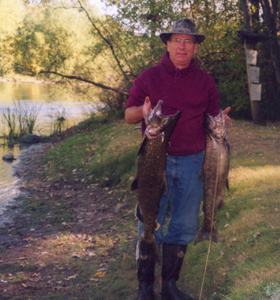MADRU’S FISH CAMP 2005

Dan Madru and his wife Connie had traveled to Newaygo on Wednesday, October 5 and set-up camp. They, along with other early arrivals, including property owner Dan Klosterman kept a cook fire going throughout the weekend. Dan Madru hangs up a tally board on a tree down by the water and fish are weighed and measured as they come in. This year’s top fish was caught by Dan’s brother, Tim Madru, registering a king salmon that weighed 16 pounds 1 ounce.
In early pioneering days, before refrigeration, salmon were smoked to provide food through the winter months. Large amounts of salt and long smoking times were needed to preserve the fish. These days…though not a necessity to get us through the winter…fish are often smoked as a popular recreational activity and a point of pride for many anglers. Today, the lightly salted and smoked fish are NOT sufficient to prevent bacterial spoilage, so smoked fish need to be refrigerated, just to be safe.
Today’s smoked fish involves 5 steps; Preparation, Salting, Drying, Smoking and Storage.
Almost any fish can be smoked but oily fish such as salmon can be brined and smoked much easier than lean fish. The salmon are either gilled and gutted, or filleted. Salmon chunks are then placed in a brine solution. Brines can be prepared by using pickling salt at 1-cup salt per gallon of water, or to taste. The salmon is placed in the brine-ice water solution for about 30 minutes.
The brined fish is then rinsed and dried before smoking. Drying accomplishes two things. It allows the salt to penetrate and become evenly distributed throughout the flesh and as the surface of the fish dries it forms a “pellicle” or tough shiney coat. The pellicle seals in moisture and makes the appearance on the finished product much better.
The fourth step is the smoking. Smoke the fish at about 140 degrees. The fish should take anywhere from 6-15 hours. Smoke the fish at 160 degrees for the last 30 minutes of the smoking cycle.
After the fish has been smoked, allow it to cool, wrap and refrigerate. Fish that is to be kept for more than 14 days should be frozen and can be kept for 2-3 months.
As the leaves begin to reach their full potential in Newaygo and as the colors drift southward from Michigan to Indiana it is a great time to be outdoors, enjoying the sights and sounds of fall and maybe enjoying a few smoked fish as well.
- What To Know About Mosquito Season - July 19, 2024
- Local Worship & Events: July 19 Update - July 19, 2024
- Allen County Bar Foundation Announces Scholarship Winners - July 19, 2024


